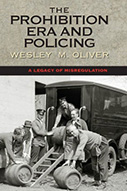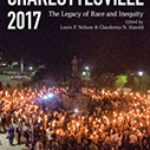The Prohibition Era and Policing: A Legacy of Misregulation

Author: Wesley M. Oliver, Professor of Law at Duquesne University
Publisher: Vanderbilt University Press, 280p.
Reviewer: Benjamin Welton | January 2019
“You have the right to remain silent. Anything you say can and will be used against you in a court of law.” Thus begins the Miranda warning that every American police officer knows so well. While Professor Wesley M. Oliver’s book The Prohibition Era and Policing: A Legacy of Misregulation is ostensibly about the problems caused by the Eighteenth Amendment (specifically the enforcement of such an unpopular and disregarded law), it is actually far more focused on Miranda v. Arizona and the inability of the exclusionary rule to reliably deter police malfeasance. Professor Oliver argues instead that, in the twenty-first century, the main concerns are wrongful convictions and the unlawful use of force by police officers. This in turn means that the American judicial system needs a recalibration if it is serious about tackling the problem of police brutality.
Despite the title of this book, the Prohibition era in American history is given surprisingly short shrift by the author. Professor Oliver instead focuses on how the process of enforcing the Volstead Act, which beginning in 1919 made the production, sale, and distribution of alcohol illegal, created concerns about state and federal violations of the Fourth Amendment. As Professor Oliver notes on page 185, “From the New York Times, to the New Yorker, to African American newspapers in Richmond and Pittsburgh, the complaints were all the same—disrespect for the Fourth Amendment, specifically illegal searches for alcohol.” While Professor Oliver, in quoting Harvard University Lisa McGirr and her outstanding 2015 book The War on Alcohol, recognizes that Prohibition enforcement mostly targeted working class and minority populations, he nevertheless argues that the hunt for booze united Americans of all stripes in their shared disgust over high-handed police tactics like warrant-less raids on private homes and businesses in search of alcohol.
This is no longer the case. Today’s America is far more concerned about the disparate impact of policing on racial minority groups, with the supposedly unbalanced use of deadly force being a chief concern. Given this reality, Professor Oliver argues that police reform initiatives from the Prohibition era, which tried to curtail illegal search and seizures and the use of coercive force in police interrogations, are no longer as pressing as they once were. Indeed, the post-Prohibition obsession with determining what evidence can be used in court has actually hampered productive police reform.
In order to support his arguments, Professor Oliver begins The Prohibition Era and Policing by talking about the development of policing in the United States. Police officers in this country were once known as “petty officers,” Oliver notes, and were not tasked with investigating crimes. That job belonged to magistrates—the very same people tasked with interviewing suspects. Magistrates have a long history in English Common Law. The same cannot be said for police officers, for our modern conception of law enforcement actually originated with customs officers who acted under writs of assistance. Unlike warrants, writs of assistance “authorized their bearers to search wherever they suspected for evidence of smuggled goods without requesting or receiving authorization from anyone” (pg. 13). These aggressive hunts by British customs agents played a key role in inspiring the American Revolution.
As surprising as it may sound to modern ears, Professor Oliver notes on page 15 that for much of our history “[v]ictims, not officers, investigated crimes, with minor assistance from officers…” In the early days of policing, America’s police officers had highly circumscribed powers, and most were drafted into the ranks for lack of other employment. For most of the early decades of policing, the American public saw police officers as mostly uncouth thugs who came from the sub-working class. They wielded clubs and sticks like an armed gang, and in cities like New York and Philadelphia, they were often the militia of political bosses. Preventing and solving crime did not enter much into the equation.
That popular viewpoint changed with the rapid urbanization and industrialization of the nation following the Civil War. Then, when the Progressive Era bloomed, urban reformers convinced the general public that a self-regulating police force full of uniformed officers chosen from civil service exam boards should be given great leeway in their pursuit of crime.
This new, more muscular brand of American policing had its coming out party during Prohibition. In order to enforce this unpopular law, police officers in places as different as Michigan and Washington State not only resorted to such grotesque practices as the “third degree,” but also utilized the latest in technology, such as wiretaps. By 1929, the administration of Republican President Herbert Hoover recognized that the American public distrusted police officers. President Hoover responded to this by creating the National Commission on Law Observance and Enforcement, otherwise known as the Wickersham Commission thanks to its chairman, former Attorney General George Wickersham. The Wickersham Commission, which detailed “the horrors in interrogation rooms” (pg. 63), made the widespread use of the “third degree” the great shame of the nation. However, despite the Wickersham Commission’s earnest attempts to stamp out police corruption and police brutality, Oliver notes in The Prohibition Era and Policing that the commission’s recommendations ultimately failed to rein in the excesses of most police departments. Sadly, American jurisprudence has been making the same mistakes, more or less, since 1929.
By focusing so much on parsing out what evidence is admissible in court, Oliver asserts that the Supreme Court has all but ignored the argument that illegally obtained evidence, if later proven valid via a confession or the discovery of a key piece of evidence (i.e. the murder weapon), can justifiably be used in court. Oliver here draws on the work of legal scholar John Henry Wigmore, who, as far back as 1905, saw “the rule [of exclusionary evidence] as grounded in an illogical sympathy for the victims of illegal searches, not an effort to deter police misconduct” (pg. 51). Oliver essentially agrees with Wigmore, and spends the final half of this book detailing all the ways in which exclusionary evidence rulings have done very little to curb police misconduct.
Oliver pays particularly close attention to the still coercive nature of perfectly legal police interrogations. In essence, so long as suspects are read their Miranda rights, then police officers can engage in all manner of potentially coercive interrogation tactics, from leading witnesses to outright lying to them. The existence of false confessions is proof enough that changes must be made to the ways in which police officers conduct interrogations.
An even more pressing matter is the issue of use of force. Professor Oliver discusses the contentious deaths of African American males Michael Brown, Eric Garner, and Tamir Rice as emblematic of the often vague and hazy definitions given to police officers about when it is appropriate to use lethal force. The Supreme Court has further complicated the matter by ruling in Tennessee v. Garner that police officers do not have a right to use lethal force on a fleeing suspect wanted in connection to a non-violent crime, while, in Graham v. Connor, the Court acknowledged that police officers must make split-second decisions about the use of lethal and non-lethal force. Given that police academies across the country train their officers in accordance with court rulings, the Court’s mixed signals are all the more worrisome.
The Prohibition Era in Policing is a detail-rich, highly informative work of legal scholarship. Professor Oliver lays out many convincing reasons why Prohibition’s most poisoned legacy is the legacy of exclusionary evidence. Professor Oliver does not argue that Miranda is an inherently bad thing. Rather, Professor Oliver uses this book to articulate alternative approaches to curtailing police misconduct that have a much better chance of succeeding.
The one major issue with this monograph is the author’s decision to place such a limited emphasis on the Prohibition era itself. While Professor Oliver is not a historian, and therefore should not be chastised for neglecting to address all the ins and outs of Prohibition, it is interesting to note that this book only lightly touches upon the reasons why the Eighteenth Amendment passed in the first place. Similarly, Professor Oliver made the decision to forgo any discussions about the more sensational side of Prohibition, with its bootleggers, mafia dons, and speakeasies. Finally, whereas McGirr in The War on Alcohol sees the 1920s as the decade when the Leviathan known as the federal state rose to prominence thanks to the interstate nature of enforcing the Volstead Act, The Prohibition Era and Policing is less about the expansion of police powers in America and more about all the ways that police power has been poorly regulated since the 1920s.
The Prohibition Era and Policing is must-read reading for any scholar or amateur enthusiastic interested in why American citizens and police officers are still grappling with the aftermath of the “Noble Experiment.”


